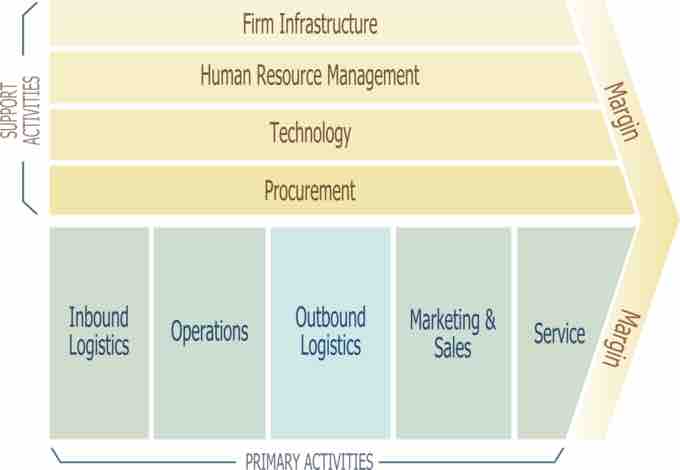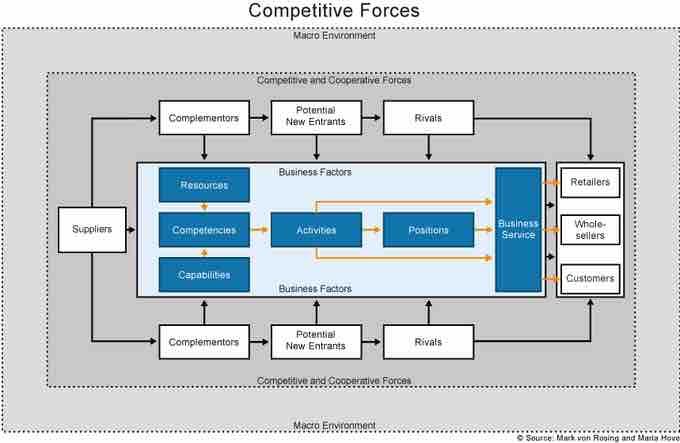Strategic management is the managerial responsibility to achieve competitive advantage through optimizing internal resources while capturing external opportunities and avoiding external threats. This requires carefully crafting a structure, series of objectives, mission, vision, and operational plan. Recognizing the way in which internally developed organizational attributes will interact with the external competitive environment is central to successfully implementing a given strategy—and thus creating profitability.
Internal Conditions
The internal conditions are many and varied depending on the organization (just as the external factors in any given industry will be). However, management has some strategic control over how these various internal conditions interact. The achievement of synergy in this process derives competitive advantage. While different businesses have different internal conditions, it is easiest to view these potential attributes as generalized categories.
A value chain is a common tool used to identify each moving part. It is a useful mind map for management to fill in during the derivation of internal strengths and weakness. A value chain includes supports activities and primary activities, each with its own components.
Supports Activities
- Firm infrastructure: the organizational structure, mission, hierarchy and upper management
- Human resource management: the skills embedded in the organization through human resources
- Technology: the technological strengths and weaknesses (such as patents, machinery, IT, etc.)
- Procurement: a measure of assets, inventory, and sourcing
Primary Activities
- Inbound logistics: deriving inputs for operational process
- Operations: running inputs through organizational operations
- Outbound logistics: shipping, warehousing, and inventorying final products
- Marketing and sales: building a brand, selling products, and identifying retail strategies and opportunities
- Service: following up with customers to ensure satisfaction, provide and fulfill warranties, etc.

Michael Porter's value chain
This model, created by Michael Porter, demonstrates how support and primary activities add up to potential margins (and potential competitive advantage). Support activities include HR management and technology; primary activities include operations, marketing and sales, and service.
External Opportunities and Threats
The external environment is even more diverse and complex than the internal environment. There are many effective models to discuss, measure, and analyze the external environment (such as Porter's Five Force, SWOT Analysis, PESTEL framework, etc.). For the sake of this discussion, we will focus on the following general strategic concerns as they pertain to opportunities and threats:
- Markets (customers): Demographic and socio-cultural considerations, such as who the customers are and what they believe, are critical to capturing market share. Understanding the needs and preferences of the markets is essential to providing something that will have a demand.
- Competition: Knowing who else is competing and how they are strategically poised is also key to success. Consider the size, market share, branding strategy, quality, and strategy of all competitors to ensure a given organization can feasibly enter the market.
- Technology: Technological trajectories are also highly relevant to success. Does the manufacturing process of the product have new technologies which are more efficient? Has a disruptive technology filled the need that was currently being filled?
- Supplier markets: Suppliers have great power as they control the necessary inputs to an organization's operational process. For example, smartphones require rare earth materials; if these materials are increasingly scarce, the price points will rise.
- Labor markets: Acquiring key talent and satisfying employees (relative to the competition) is critical to success. This requires an understanding of unions and labor laws in regions of operation.
- The economy: Economic recessions and booms can change spending habits drastically, though not always as one might expect. While most industries suffer during recession, some industries thrive. It is important to know which economic factors are opportunities and which are threats.
- The regulatory environment: Environmental regulations, import/export tariffs, corporate taxes, and other regulatory concerns can poise high costs on an organization. Integrating this into a strategy ensures feasibility.
While there are many other external considerations one could take into account during the strategic planning process, this list gives a good outline of what must be considered in order to minimize unexpected threats or missed opportunities.
Strategic Analysis
With both the internal value chain and external environment in mind, upper management can reasonably derive a set of strategic principles that internally leverage strengths while externally capturing opportunities to create profits—and hopefully advantages over the competition.

Competitive and cooperative forces
This chart diagrams the external factors that should be considered when analyzing a firm's strategy. Competitive and cooperative forces include rivals, new entrants, suppliers, and retailers; business factors include resources and capabilities.